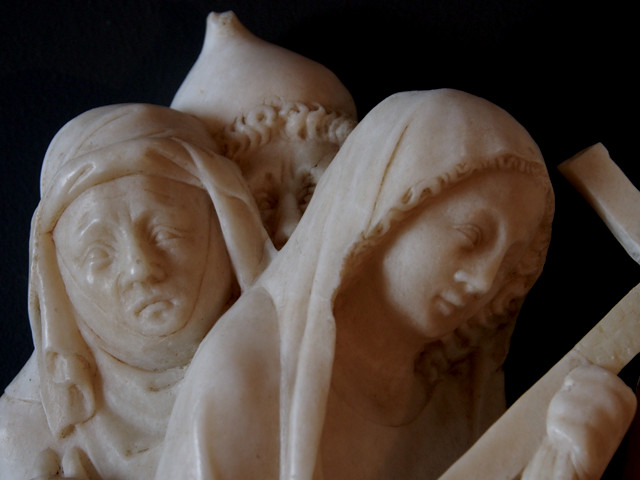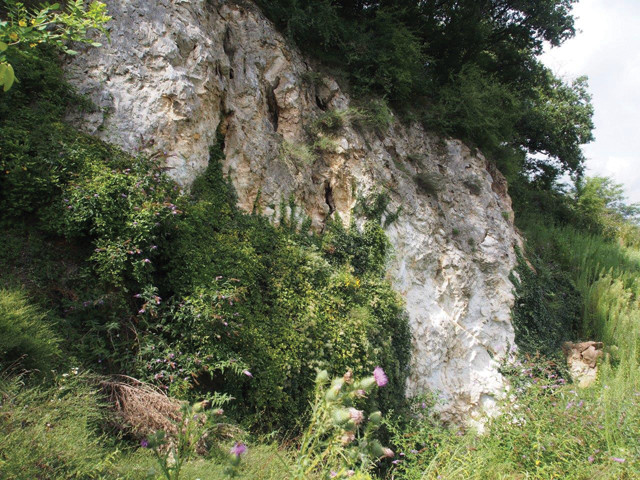
by Lauren Milideo Thursday, February 15, 2018

Close-up of a 14th-century alabaster panel in the Louvre Museum in Paris. Credit: Wolfram Kloppmann.
When geologists think of alabaster, they likely envision blocks of gypsum, its main mineral constituent; when art historians hear the word, statues crafted from the soft rock may come to mind. A new study focused on the sources of centuries-old alabaster artworks has geologists thinking about art history, and art historians pondering geochemistry. In the study, published in Proceedings of the National Academy of Sciences, researchers used isotope fingerprinting along with historical records to tie medieval and Renaissance alabaster sculptures to the quarries from which their materials were excavated.
Wolfram Kloppmann, a geochemist at the French Geological Survey, and his colleagues analyzed isotopes of strontium, sulfur and oxygen in samples of alabaster from different quarries in England, France, Germany, Italy and Spain. Geologic maps and archived historical records found with the help of local historians, such as a 1277 document granting residents permission to utilize gypsum from the Malaucѐne territory in Provence, France, guided the researchers to the locations of former quarries, Kloppmann says. Then the team sampled them to assemble a database of isotopic signatures for the quarries.
The contrasts in isotopic composition are very strong for those three elements, especially for sulfur and strontium, among alabasters from historical quarries, Kloppmann says. While the geochemical signatures within each quarry are consistently similar, each quarry’s signature varies significantly from the others. “So we can nicely discriminate between the deposits,” he says. “These are rather ideal conditions for geochemical fingerprinting.”
The researchers then turned their attention to alabaster artwork to see if they could determine where the raw material for different pieces had originated. They worked with representatives from the Louvre in Paris and other French, American and European museum collections, ultimately collecting tiny, 20-milligram samples from dozens of sculptures, mainly French, dating from the 12th through the 17th centuries. They then matched the isotopic signatures from the sculptures to those from different quarries in their database.
The team found that the alabaster in most of the sculptures originated in French quarries, although English quarries also produced some of the alabaster tested, and the material in a couple of pieces was from Spain or Italy. The origins of several pieces remain unidentified.
Using this “attribution of provenance,” researchers can reconstruct pictures of historic alabaster mining and trade routes, Kloppmann says. For example, the researchers identified a little-known French Alpine alabaster quarrying industry that was active for five centuries.
Alabaster for several 14th-century funeral monuments in the French city of Avignon traced back to a single location in the French Alps, Kloppmann notes. Analysis of these sculptures, which date to when the papacy was located in Avignon, showed that the Rhône River had served as a means of transport for alabaster quarried upstream in the mountains. In other cases, it was clear alabaster had been transported across river valleys over land. Identifying such historical trade routes is an important goal, says Juan Madariaga, a chemist at the University of the Basque Country in Spain.

This outcrop near the French town of Notre-Dame-de-Mésage near Grenoble was once part of a gypsum and alabaster quarry in the Alps. Credit: Wolfram Kloppmann.
The isotopic fingerprinting work has other applications as well, Kloppmann says, including identification of restorations. In one case, two 14th-century statues originally from a small French church found their way separately to the Louvre and to the Cleveland Museum of Art. Surprisingly, the isotopic signatures of the pieces were found to be very different, Kloppmann says. Upon further examination, the team realized that the Louvre statue had been repaired at some point with alabaster from a different source; the restoration was done so well, it had previously gone undetected. When the team analyzed a sample from an original portion of the statue, the isotopic signatures matched those of the piece from the Cleveland museum so closely that it’s possible they could have come from the same alabaster block, Kloppmann says.
Counterfeits, too, can be detected with isotopes. For example, Kloppmann says, if a piece is purported to be from a certain time period, yet its alabaster is found to have originated from a site that was not being quarried at that time, something is amiss.
Kloppmann says he and his colleagues plan to continue expanding both the temporal and geographic reach of the research, noting it could eventually be useful for identifying the sources of alabaster sculpture from antiquity. The team is working now to expand their database of isotopic signatures to historic quarries in Eastern Europe, although useful historic records to help identify these locations are scarce, he says.
Expanding the range of isotopes studied could also help broaden the applicability of this work, Madariaga says. “But with the set of samples they have studied, and with the method they have used,” the study’s conclusions are sound.
© 2008-2021. All rights reserved. Any copying, redistribution or retransmission of any of the contents of this service without the expressed written permission of the American Geosciences Institute is expressly prohibited. Click here for all copyright requests.